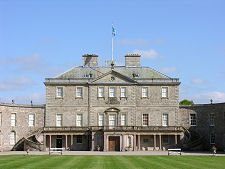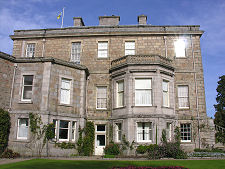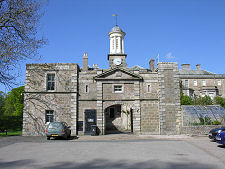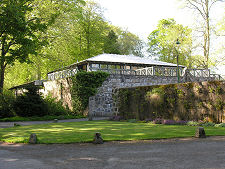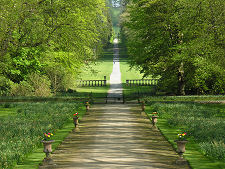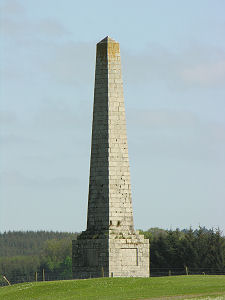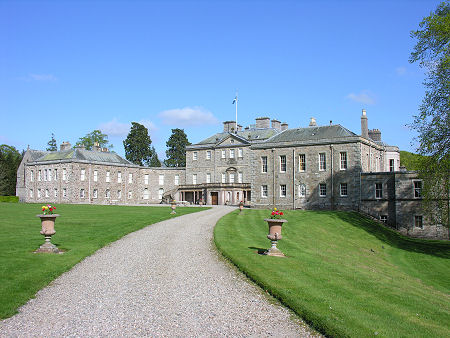 Haddo House from the West |
Haddo House is a spectacular country house designed by William Adam and built in the years between 1731 and 1736. Today the house is owned by the National Trust for Scotland and open to the public. The surrounding country park is operated by Aberdeenshire Council, while the extremely large Haddo Estate, of which the country park forms only a small part, continues to function as a farming and sporting estate.
And, covering some 7,500 acres, the Haddo Estate is very large indeed. From the gates accessing the south side of the estate near Tarves, the drive you follow to the car park near Haddo House itself is an impressive mile and a half in length, and only in a couple of places do the surrounding public roads come within a mile of the house.
Before turning to the house itself, it is worth knowing that the country park, which was established in 1980, offers the opportunity to roam over some 200 acres of beautiful countryside. Here you find parkland, woods, and monuments, plus a large lake and ponds. The main axis of the park follows the "central drive" a straight drive that runs for, reputedly, one Scots mile (which is about 10% longer than a standard mile) south-east from the centre of the house right through the garden and park.
Closer to Haddo House on its south-east side are more formal gardens which visitors can also enjoy: here the line of the central drive is marked by a large fountain erected in the mid 1800s.
The NTS visitor centre in the house's converted stable and coach house block includes a tea room, a shop and other facilities available to all visitors to the park, while nearer the car park is the Haddo Estate Shop. Included within the complex of buildings at the heart of the estate is Haddo House Hall, a theatre that is home to the Haddo Arts Trust and the Haddo Choral Society. The nearby "peatyards" building houses rehearsal rooms for the theatre, and a bar.
The true focal point of the estate is inevitably Haddo House itself. This comprises a substantial main block of three storeys by seven bays wide and five deep flanked by two storey quadrants linking to wings that are two storeys high and five(ish) bays wide. The architectural textbooks describe it as "Reticent Palladian". Most of us will settle for the more straightforward "magnificent". Haddo House was a house definitely built to impress: and it succeeds hands down.
Having said that, Haddo was also obviously designed and built in an age before it mattered much whether the house was easy to photograph. The main front of the house faces north-west, meaning that you only catch it in sunlight in the late afternoon or evening in summer. This also means, of course, that the gardens, which lie to the rear, south-east, side of the house can enjoy the sunlight for much of the time: which, in fairness to William Adam, was probably a more important consideration in 1731.
As originally designed by Adam, the main entrance to the central block of the house was at first floor level. Adam's original quadrants were also only a single storey in height. This all changed in 1822, when the house was reconfigured by the Aberdeen architect Archibald Simpson. He moved the entrance to the ground floor, where you find it today, and he added an upper storey to the quadrants, making them a much more significant part of the overall look of the house.
Other changes were also made to Haddo House later in the 1800s. The most striking was the addition of a chapel which was built between 1876 and 1891 to the north-east of the north-east wing of the house. This helped balance the service wing built at a lower level to the south-west of the opposing wing.
Today's visitors enters Haddo House via the ground floor door in the centre of the main block. In doing so they are following a well trodden path. Haddo House was the first of Scotland's grand stately homes to open its doors to the public, which it did in 1883 after an advertisement had been placed in The Scotsman.
Within the house you find yourself in the magnificently panelled main hall. From here your guided tour takes you up to the first floor of the house, where you move through the ante room, which started life as the hall behind the first floor main entrance, before climbing again, this time to the landing on the second floor, called "the square" and lit via the square cupola in the centre of the roof. Among the exhibits on display are the robes worn by the Marquess and Marchioness of Aberdeen at the coronation of Queen Elizabeth II in 1953.
From here you move through to the queen's bedroom, named after Queen Victoria, who stayed here in June 1857. A second bedroom is home to a half tester bed. After descending once again to the first floor you continue to move through a series of ever more impressive rooms. These include the large but surprisingly comfortable and intimate morning room, the sumptuous drawing room, and the magnificent dining room, occupying most of one side of the main block of the house. Here the visitor's attention is inevitably drawn to the wheeled silver galleon on display. This has a hull capable of holding a wine bottle, and the idea was that it would be wheeled up and down the dining table as needed. Depending on your outlook on the world, you inevitably end up wondering either (a) how on earth it is kept clean or (b) how narrow metal wheels could avoid wrecking the surface of the dining table. Or possibly both.
From the dining room and neighbouring china room you proceed round the upper floor of the north-eastern quadrant to the wing on this end of the house. The quadrant itself is home to more of the paintings which thickly decorate every wall in the house and contribute so much to a visit to Haddo. It also houses a series of busts, and a line of low bookshelves. This is your hint to what lies at the far end of the quadrant, Haddo House's very large library.
Beyond the library you descend into the chapel, a much larger space than an outside view leads you to expect. The chapel is dominated by the stained glass windows which occupy much of its two end walls, and by the large organ, which you feel must be audible through much of the house when in full flow. Next stop on the tour are the rooms on the ground floor of the north-east wing. These include the Gordon room containing family memorabilia, and a room displaying a series of stuffed animals and birds exhibited in glass cases. A 21st Century audience can find evidence of the Victorian need to kill and stuff wildlife in order to enjoy it a little overpowering: but however you view it, this is an interesting record of part of a world now long gone.
But... this account actually skips over a totally unexpected highlight of a visit to Haddo House. This is the Giles room. Here you find on display 85 magnificent watercolour paintings of Scottish castles completed by Aberdeenshire artist James Giles over 17 years in the mid 1800s as part of a commission from the Marquess of Aberdeen. Once finished, they appear to have been stored away and forgotten. Which goes a long way to explaining why they appear so fresh and vital. Truly a remarkable find.
The story of the Haddo House is closely associated with the story of the family who built it, and who have lived here continuously from the time it was built. The Gordons of Haddo trace their ancestry back to Gordons known to have lived in Berwickshire in the 1170s. Fast forward a couple of centuries, and the family had settled in Huntly, later becoming Earls and Marquesses of Huntly. In 1469 a descendent of this line of the family, James Gordon, acquired the estates of Haddo and Meikle Methlick in 1469. Having built a fortified tower house, the House of Kelly, to secure their powerbase in the area, succeeding generations of Gordons then set to work to extend their estates at Haddo Estate and more widely across Aberdeenshire.
The mid 1600s were a difficult time for the Gordons, as for many other families, as civil and religious wars swept across Scotland. At one point in the 1640s the House of Kelly was attacked and sacked. Things started to look up in 1665 when George Gordon, a lawyer, inherited the estate on the death of his brother. In 1682 he was appointed High Chancellor of Scotland and made 1st Earl of Aberdeen. He also added greatly to the family estates.
On George's death in 1720 at the age of 83, his son William became 2nd Earl of Aberdeen. It was he who commissioned William Adam to build Haddo House in 1731. William married three times and had seven sons and three daughters before dying suddenly in Edinburgh while supporting Bonnie Prince Charlie in 1745. If he hadn't died of natural causes when he did, he would almost certainly have had his by now vast estates confiscated by the government, as happened to many Jacobite sympathisers. Instead, when his son George became 3rd Earl of Aberdeen he found himself to be the largest landowner in Aberdeenshire.
Another George, George Hamilton-Gordon became the 4th Earl of Aberdeen in 1801 on the death of his grandfather. A student at Cambridge at the time, he returned to Haddo House to find it in a poor state and severely in need of renovation and updating. It was the 4th Earl who developed much of today's Haddo House and estate, as he commissioned the 1822 rebuilding and undertook a vast tree-planting program to turn what was then very bleak countryside into the parkland you see today. More widely the 4th Earl forged a very successful political career, culminating in his time as Prime Minister from 1852-5. He was also responsible for interesting Queen Victoria in Aberdeenshire, and persuading her to lease Balmoral Castle in 1848 and buy it four years later.
The 5th Earl enjoyed his inheritance for just four years before he died, leaving his 23 year old son, yet another George, to become the 6th Earl in 1864 at the age of just 23. He responded by packing up and leaving, spending the next seven years as "George Osborne" working as a lumberjack in Canada and a mariner. He was lost at sea off Australia in 1870, at the age of just 30. John Hamilton-Gordon, the 7th Earl, inherited an estate that had continued to grow during his predecessor's seven year disappearance, amounting to 65,000 acres of Aberdeenshire and a huge income. He went on to become Viceroy of Ireland and Governor General of Canada, and in 1916 was made the 1st Marquess of Aberdeen and Temair. It was John Hamilton-Gordon and his wife, Ishbel, who built the chapel at Haddo House.
When the 4th Marquess, David Gordon, died in 1974 he left Haddo House and its garden to the National Trust for Scotland. The house has been open to the public since 1979.
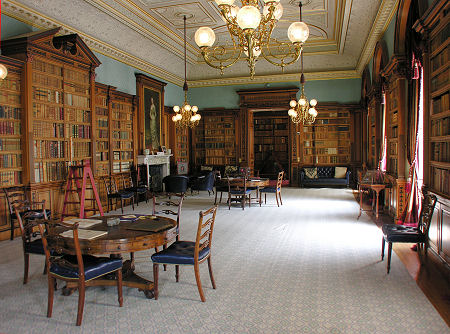 The Library |

|
|
|
Visitor InformationView Location on MapSTB 4 Star Visitor Attraction Ellon, AB41 7EQ. Tel: 01651 851440. haddo@nts.org.uk Grid Ref: NJ 868 348 www.nts.org.uk NTS: Haddo House Web Page Opening Hours Admission Accessibility What3Words Location: ///jolt.observers.instead |
 The Panelled Main Hall |
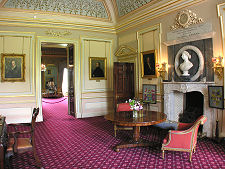 Ante Room, Originally the Hall |
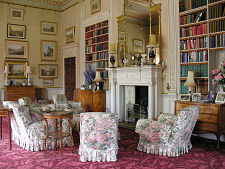 The Morning Room |
 The Drawing Room |
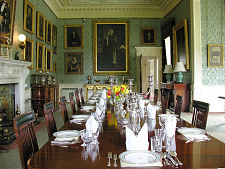 Dining Room |
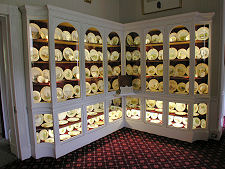 China Room |
 Staircase |
 The Square |
 The Queen's Bedroom |
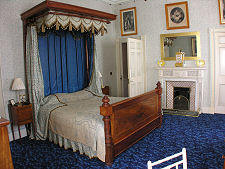 Half Tester Bed |
 The Quadrant Leading to the Library |
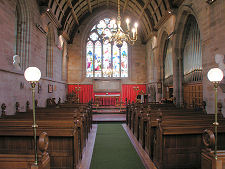 The Chapel |
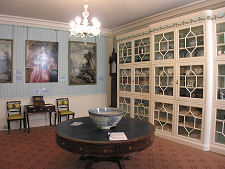 The Gordon Room |
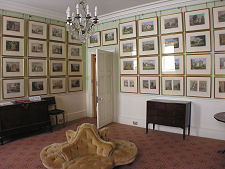 James Giles Castle Paintings |
 Taxidermy Display |
